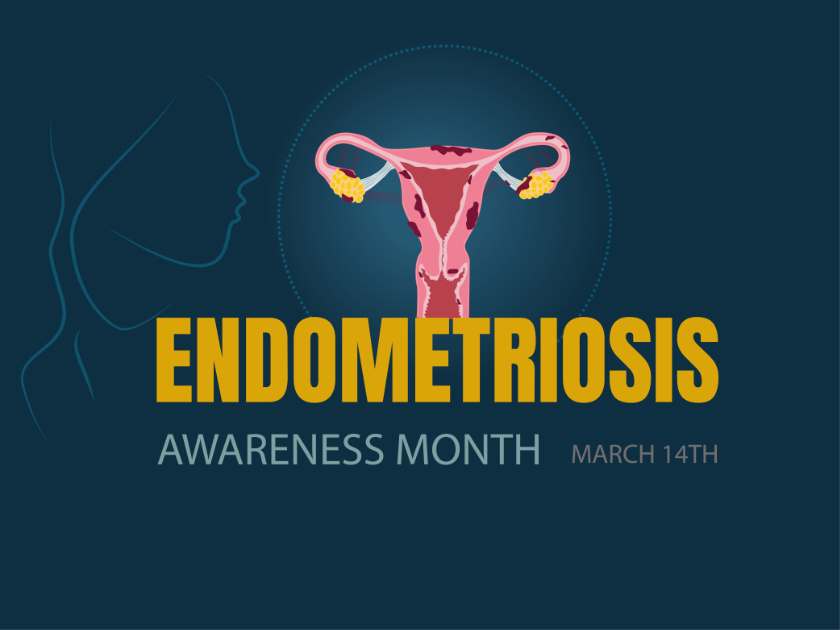
March is National Endometriosis Month

The Endometriosis Association began the event in 1993. Today, National Endometriosis Awareness Month is a worldwide event that brings attention to this painful condition.
About Endometriosis
Endometriosis is a condition that affects the endometrium, which is the mucous membrane that lines the uterus, or womb. The endometrium thickens during the menstrual cycle in preparation for the potential implantation of an embryo.
Endometriosis develops when this tissue that normally lines the inside of the uterus grows outside of the uterus. These clumps of tissue are known as endometrial implants. The tissue can even grow on other female reproductive organs, such as the ovaries and fallopian tubes, or on the intestines.
Symptoms of endometriosis include:
- Painful periods
- Irregular bleeding
- Pain during sex
- Digestive problems
- Infertility
Endometriosis may affect more than 11 percent of all women between the ages of 15 and 44, according to the US Department of Health & Human Services’ Office on Women’s Health. The condition is especially common among women in their 30s and 40s. Endometriosis is often misdiagnosed or missed altogether because of lack of awareness and education about the condition.
There is a general lack of awareness about endometriosis, as many think the severe symptoms are part of a normal menstrual cycle. This lack of awareness can contribute to delayed diagnosis for many women.
Diagnosis and Treatment of Endometriosis
To diagnose endometriosis, the doctor will ask you to describe your symptoms, including the location of the pain and how often it occurs. Next, the doctor will perform a pelvic exam to palpate, or manually feel, cysts, scars or other abnormalities.
In some cases, the doctor will order imaging tests, such as:
- Ultrasound that uses a handheld device and sound waves to create images, which can help the doctor identify cysts associated with endometriosis
- Magnetic resonance imaging (MRI) that uses a magnetic field and radio waves to create images of organs and tissues inside the body; a surgeon may use MRI images to gain information about the location and size if endometrial implants
- Laparoscopy – a procedure in which a surgeon inserts a slender viewing instrument, known as a laparoscope, into a tiny incision in the abdomen; this procedure can help the surgeon look for signs of endometrial implants and determine their size, extend, and location
Treatment for endometriosis
Treatment for endometriosis typically involves medication or treatment. The specific treatment depends largely on the severity of signs and symptoms, and whether you hope to get pregnant. Doctors usually suggest conservative treatment with medications first before recommending surgery.
Treatments for endometriosis include:
- Over-the-counter pain medication, such as nonsteroidal anti-inflammatory drugs (NSAIDs) ibuprofen or naproxen sodium to help ease painful menstrual cramps; if you are not trying to get pregnant, your doctor may recommend taking these non-prescription pain relievers in addition to hormone therapy
- Hormone therapy to reduce or eliminate the pain of endometriosis; therapies may include hormonal contraceptives, aromatase inhibitors that reduce the amount of estrogen in the body, and gonadotropin-releasing hormone (Gn-RH) agonists and antagonists that create an artificial menopause to shrink endometrial tissue, progestin therapy to stop menstrual periods and halt the growth of endometrial implants
- Conservative surgery to remove endometrial implants while preserving the uterus and ovaries; this procedure can help improve a woman’s chances of becoming pregnant
- Fertility treatments to improve a woman’s chances of getting pregnant
- Hysterectomy with removal of the ovaries
How to Participate in National Endometriosis Awareness Month
You can participate in National Endometriosis Awareness Month in a wide variety of ways.
Educate Yourself
Learn all you can about endometriosis, its diagnosis and treatment. Share this information with friends, family, and co-workers.
Get Marching
Organize a march or participate in an existing march. Endometriosis Worldwide March is a virtual event that takes place on March 26, 2022. This global event always takes place on the last Saturday in March. The Rock ‘n’ Roll Running series will host an event in Washington DC on that same date.
Share Your Story
If you or someone you love has had endometriosis or currently have the condition, share your story with friends, family, and others in your community. Many women are unaware that there are treatment options for endometriosis.
Join an Organization
The Endometriosis Association was the first organization in the world for women with endometriosis, and it is still a strong voice for women with the condition. Healthy Women is a woman’s health organization that helps women ages 35 to 64 make informed health decisions.
Use Social Media
Social media is a powerful tool for raising awareness about endometriosis. Use the hashtag #endometriosis on your Facebook, Twitter, Instagram or other social media platforms when posting about endometriosis.
For more information on endometriosis and ideas on how to raise awareness of the condition, consult with your doctor.




